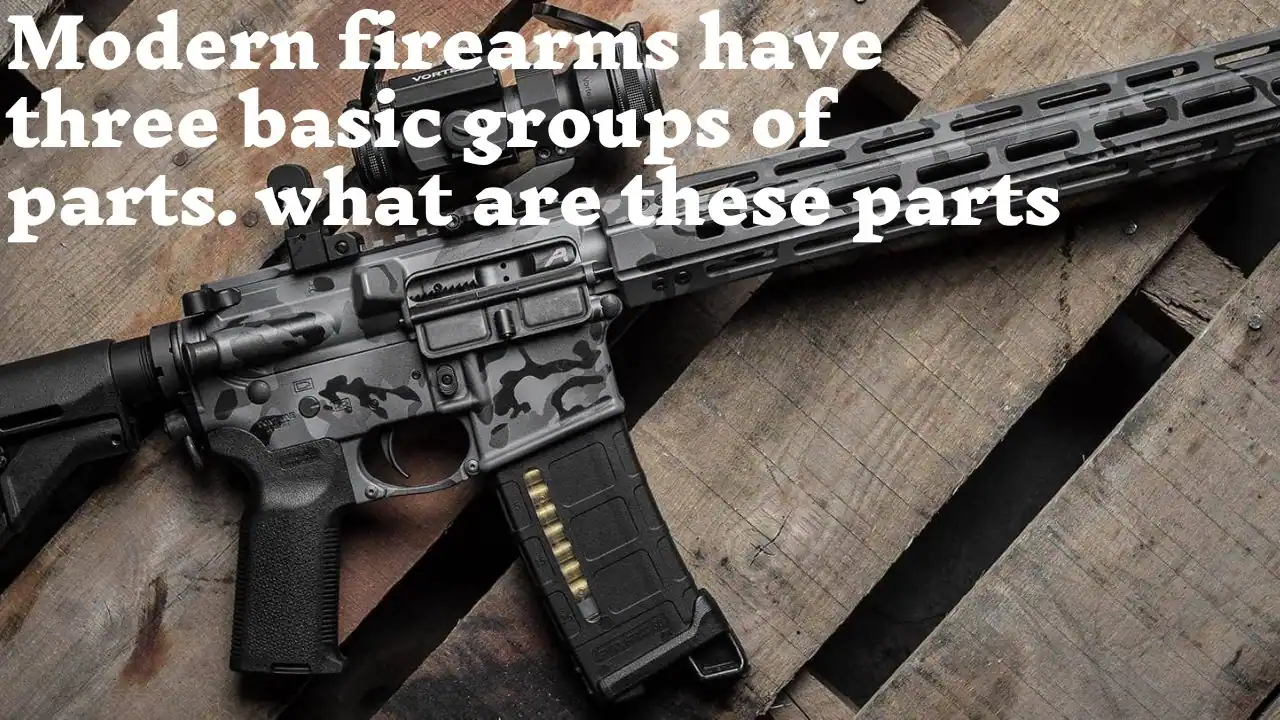Whether you’re a gun enthusiast, someone who enjoys shooting as a hobby, or curious about how firearms work, it’s crucial to grasp the intricacies of barrels, actions, and stocks. Come along as we delve into the core of firearm technology. We’ll not break down each component. Also, tackles common questions, clears up misconceptions, and offers advice on responsible ownership and maintenance practices. Let us uncover the mysteries, dispel any myths, and equip ourselves with knowledge that goes beyond pulling the trigger. Welcome to the world of firearm anatomy – where every piece has a unique tale.
The Three Basic Groups of Parts:

Barrel Group:
- Barrel: A metal tube that guides the projectile path.
- Muzzle: The front opening of the barrel where the projectile emerges.
- Chamber: The back portion of the barrel where the cartridge is loaded and set for firing.
- Rifling: grooves within the barrel that spin the projectile to enhance accuracy.
Action Group:
- Bolt: Moves back and forth to load, chamber, and extract cartridges.
- Firing Pin: Strikes the primer of a cartridge, initiating the firing sequence.
- Extractor: Grasps and removes spent cartridge cases from the chamber.
- Ejector: Expels extracted cartridge cases from the firearm.
Stock Group:
- Stock: The main structural component, providing a point of contact for the shooter and housing the action and barrel.
- Grip: Located on the stock, it is the area where the shooter holds and controls the firearm.
- Buttplate or Buttstock: Positioned at the rear of the stock, it absorbs recoil and enhances stability.
- Forend: The front part of the stock that supports the barrel and provides an additional gripping surface.
Exploring the Essence of Barrels in Firearms

When delving into the realm of firearms, one cannot overlook the role that barrels play. These cylindrical parts, often underestimated by onlookers, wield influence on a firearm’s performance and precision. Join me as we delve into the domain of barrels, uncovering their structure, importance, and how they shape the firearm encounter.
The Anatomy of Barrels:
Barrels, typically made from steel or aluminum, serve as the conduit through which a bullet travels. The construction and composition of a barrel influence its durability, weight, and performance. Rifled barrels, featuring spiral grooves on the inner surface, are a hallmark of modern firearms, imparting spin to the bullet for enhanced accuracy.
Barrel Length Matters:
Have you ever wondered why guns have barrel lengths? The size of the barrel impacts both accuracy and speed. Longer barrels usually lead to bullet speed, whereas shorter barrels provide ease of handling. Understanding this balance is crucial for choosing the right firearm based on your preferences and intended use.
Maintenance for Longevity:
Just like any precision instrument, barrels require proper maintenance. Fouling, corrosion, and wear can impact performance. Regular cleaning, using appropriate solvents and brushes, ensures the longevity of your firearm’s barrel. Remember to inspect for signs of wear and tear, as addressing issues early can prevent more significant problems.
Beyond the Basics: Specialized Barrels:
For those seeking enhanced performance, specialized barrels cater to specific needs. Fluted barrels dissipate heat more efficiently, reducing the risk of overheating during rapid fire. Match-grade barrels are precision-engineered for superior accuracy, making them a favorite among competitive shooters.
Firearm Actions: Heart of Functionality

In the intricate tapestry of modern firearms, the action group stands as the beating heart, dictating the rhythm of a weapon’s operation. Delving into the world of firearm actions reveals a diverse landscape, each type offering distinct advantages and considerations. Join us as we unravel the mechanics behind bolt-action, semiautomatic, and automatic actions, exploring their nuances and helping you navigate the diverse array of firearms available.
Bolt-Action Brilliance:
Bolt-action firearms, characterized by their manually operated bolt mechanism, offer simplicity, precision, and reliability. The shooter manually cycles the bolt to eject the spent cartridge and load a new round. This straightforward design contributes to accuracy, making bolt-action rifles a preferred choice for precision shooting, hunting, and long-range engagements.
Embracing Semiautomatic Efficiency:
Semiautomatic actions offer a boost in efficiency and quick response times. In contrast to bolt firearms, automatic guns automatically expel the used cartridge and load a fresh round every time the trigger is pulled. This semiautomatic feature enables follow-up shots, making it a favored option for self-defense, recreational shooting, and tactical uses.
The Dynamics of Automatic Actions:
Automatic weapons elevate the idea of firing to a new level. These guns keep shooting as the trigger is pressed, automatically loading cartridges into the chamber. Despite their firepower, automatic firearms are subject to regulations and frequently limited in civilian usage. They are predominantly utilized by military and law enforcement agencies for their ability to provide fire.
Navigating the Pros and Cons:
Different types of actions have benefits and factors to consider. Bolt action is great for accuracy, while automatic provides a mix of speed and precision while delivering superior firepower. Knowing the details of each type helps you pick the firearm for your purpose, be it hunting, target shooting, or self-protection.
The Terrain: Firearm Stocks

Stocks are components in the world of firearms, acting as the connection point between the shooter and the mechanical parts of the weapon. Let’s delve deeper into this aspect of firearm design, examining the range of stock variations and how they influence both comfort and performance for shooters.
Anatomy of a Firearm Stock:
A gun’s stock serves a role beyond being a grip; it plays a vital part in maintaining the weapon’s balance and handling. Stocks are commonly crafted from wood, polymer, or composite blends, each providing characteristics that impact how the firearm is used, like strength, weight, and appearance.
The Role of Stocks in Recoil Management:
When you fire a gun, the recoil, which is its movement, is something every shooter has to deal with. How the firearm stock is. What it’s made of affects how the recoil is handled and spread. Having features that help absorb recoil, like recoil pads or adjustable buttstocks, can make shooting more comfortable, especially when using firearms.
Tailoring Stocks to Individual Comfort:
Stocks come in various types and sizes to suit various body shapes and shooting styles. Adjustable stocks enable shooters to personalize the length of pull for an ergonomic feel. This flexibility is especially useful for individuals who share a firearm with others.
Folding and Collapsible Stocks:
For those requiring compactness and portability, folding and collapsible stocks offer a space-saving solution. They allow for easy storage and transport, making them suitable for applications where space is at a premium, such as tactical or survival scenarios.
Stocks and Aesthetics:
The appearance of a stock goes beyond its practicality. It plays a significant role in enhancing the visual charm of a firearm. Wooden stocks, showcasing grain patterns, exude an enduring elegance, whereas contemporary synthetic stocks boast streamlined and functional designs. Selecting a stock that reflects your taste brings an individualized touch to your firearm.
Firearm Stocks: Balancing Form and Function
In the realm of firearms, stocks are crucial for enhancing the user experience, acting as a link between the shooter and the weapon. These elements frequently impact both the comfort and effectiveness of a firearm. Come along as we delve into the details of firearm stocks, unveiling an array of designs, materials, and customization choices tailored to shooting preferences.
The Backbone of Comfort: Stock Basics
Firearm stocks are the backbone of a gun, linking the barrel and action together and offering a grip for the shooter. They are available in fixed, folding, and collapsible styles. Stock selection can influence aspects like comfort, stability, and ease of handling a firearm.
Stock Materials: The Impact on Performance
The components used to make a stock are vital to its performance. Stocks can be made from materials like wood, synthetic polymers, or composite materials. Each material has pros and cons that impact aspects such as weight, toughness, and how well it holds up in environments.
Customization Options: Tailoring Your Firearm Experience
Gun lovers frequently look for ways to customize their firearms, and stocks provide a range of personalization options. Whether it’s adjusting cheek risers or adding accessory rails, these upgrades enable shooters to tailor their guns to suit their preferences. Knowing the choices available gives users the ability to craft a comfortable shooting setup.
Specialty Stocks for Specific Needs
Different shooting activities may call for specialized stocks designed to meet specific requirements. Thumbhole stocks, for example, offer enhanced control and are favored by precision shooters. Pistol grips on tactical stocks provide a secure grip for quick maneuvering. Understanding these specialty stocks ensures your firearm is optimized for its intended purpose.
Maintenance and Care: Ensuring Longevity and Performance
Proper maintenance of firearm stocks is crucial for both longevity and optimal performance. Regular cleaning and inspection help prevent issues such as cracks or warping. Depending on the material, different cleaning methods may be required to preserve the stock’s appearance and structural integrity.
Conclusion:
In examining gun structure, we’ve carefully analyzed the parts that form the core of firearms. From barrels that guide the trajectory of the bullet accurately to action mechanisms that determine the operation of a weapon and stocks serving as the connection between shooter and firearm, we’ve revealed the mysteries behind their design, significance, and personalization. As we wrap up this exploration into firearm structure, it becomes evident that responsible ownership and upkeep practices are just as crucial as comprehending the parts themselves. Equipped with this understanding, enthusiasts, hobbyists, and those curious can navigate the world of firearms with consideration and informed choices.
FAQ:
Q1: Why is barrel length significant in firearms?
A1: Barrel length influences both accuracy and speed. Longer barrels generally increase bullet speed, while shorter barrels provide easy handling. Understanding this balance is crucial for choosing the right firearm based on your preferences and intended use.
Q2: What are the advantages of different firearm actions?
A2: Bolt-action rifles offer simplicity, precision, and reliability; semiautomatic rifles provide efficiency and quick response times, and automatic rifles deliver superior firepower. Each type has benefits, and knowing the details helps you choose the firearm that aligns with your purpose.
Q3: How do stocks impact recoil in firearms?
A3: The material and design of a stock affect how recoil is handled and spread out. Features like recoil pads or adjustable buttstocks can make shooting more comfortable, especially when using firearms with significant recoil.
Q4: What are the benefits of customized firearm stocks?
A4: Customization options, such as adjusting cheek risers or adding accessory rails, allow users to tailor their guns to suit their preferences. Specialty stocks for specific needs, like thumbhole stocks for enhanced control or pistol grips for quick maneuvering, ensure your firearm is optimized for its intended purpose.
Q5: Why is proper maintenance essential for firearm stocks?
A5: Regular cleaning and inspection are crucial for firearm stocks’ longevity and optimal performance. Different cleaning methods may be required based on the material to preserve the stock’s appearance and structural integrity.






